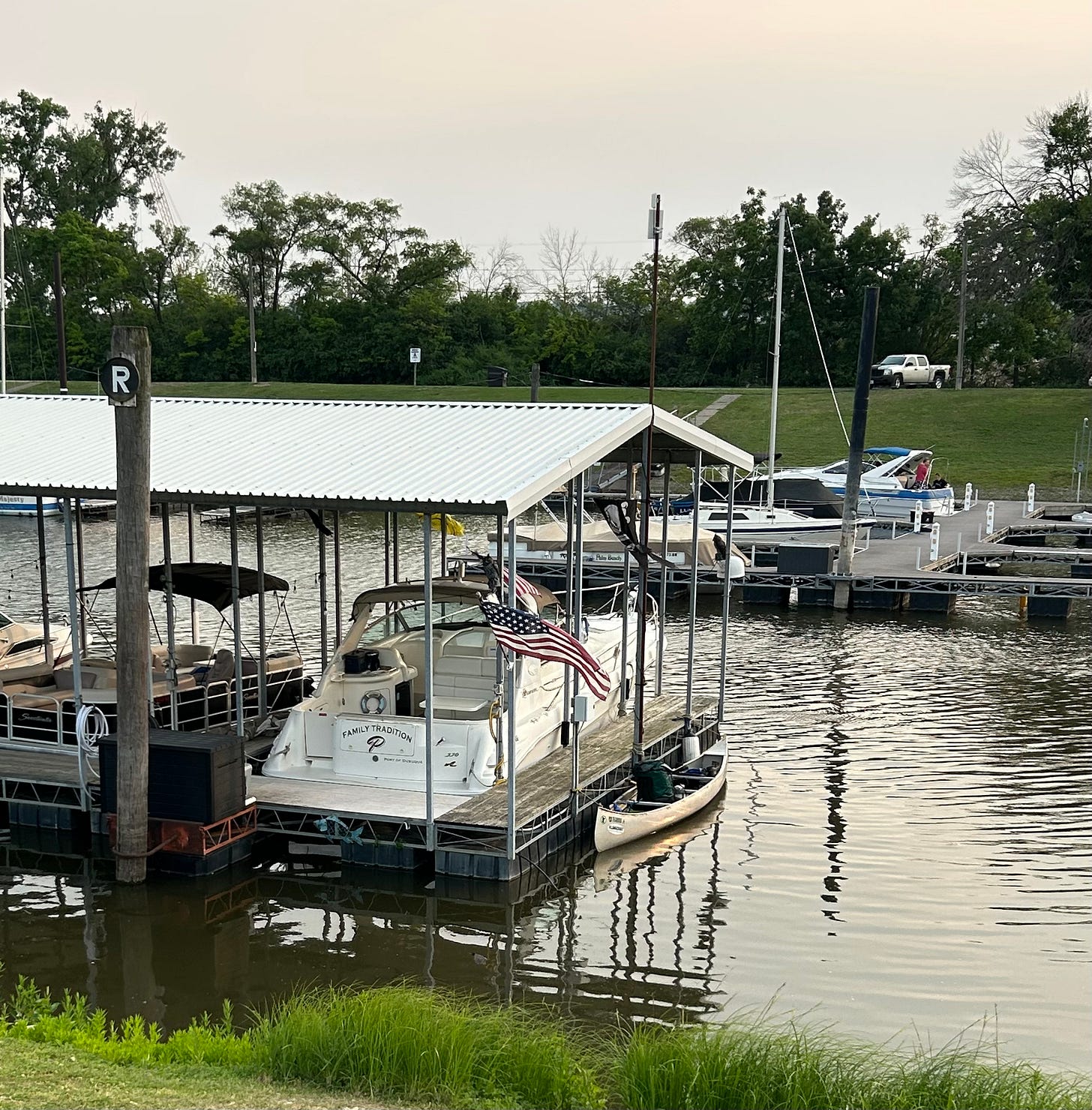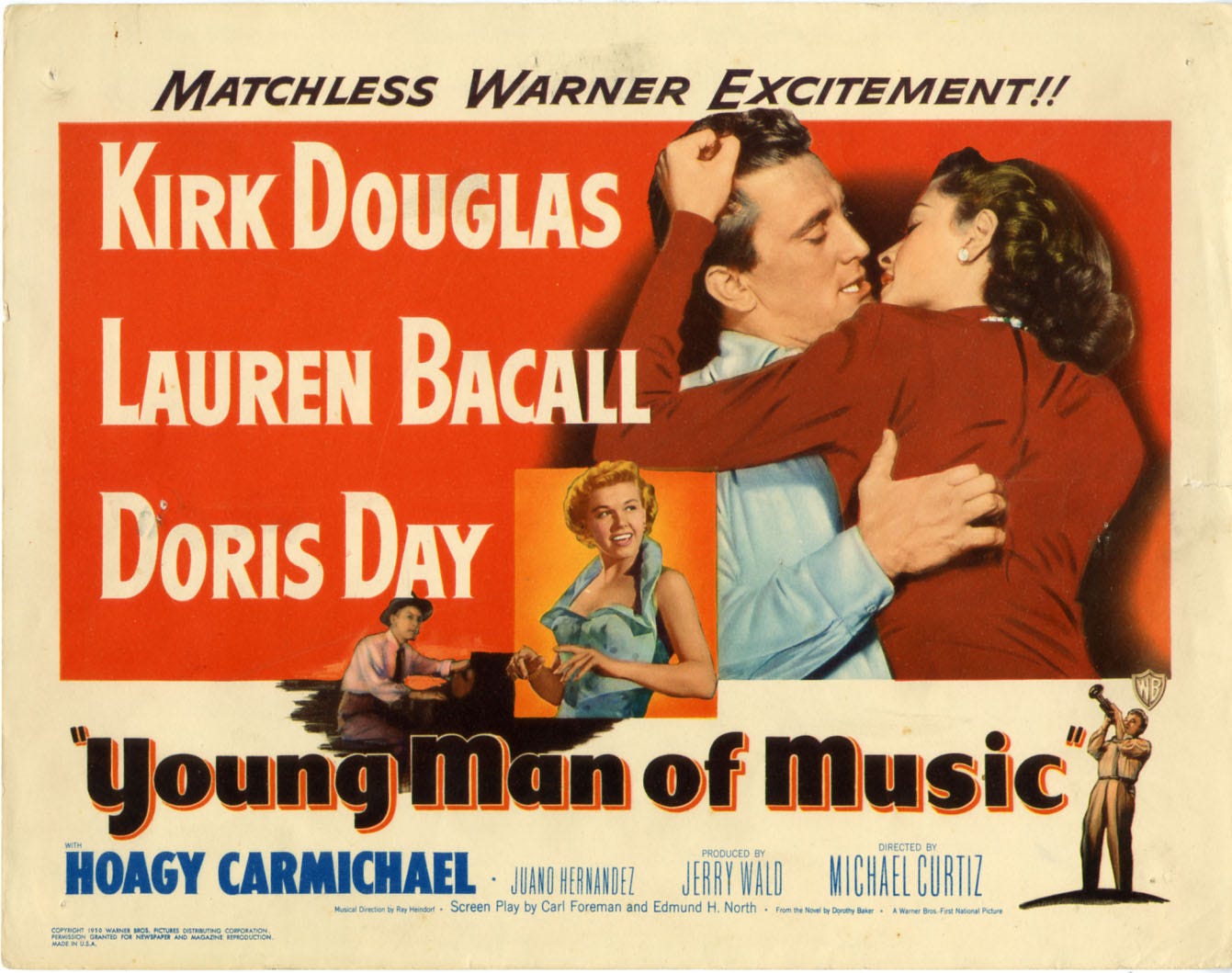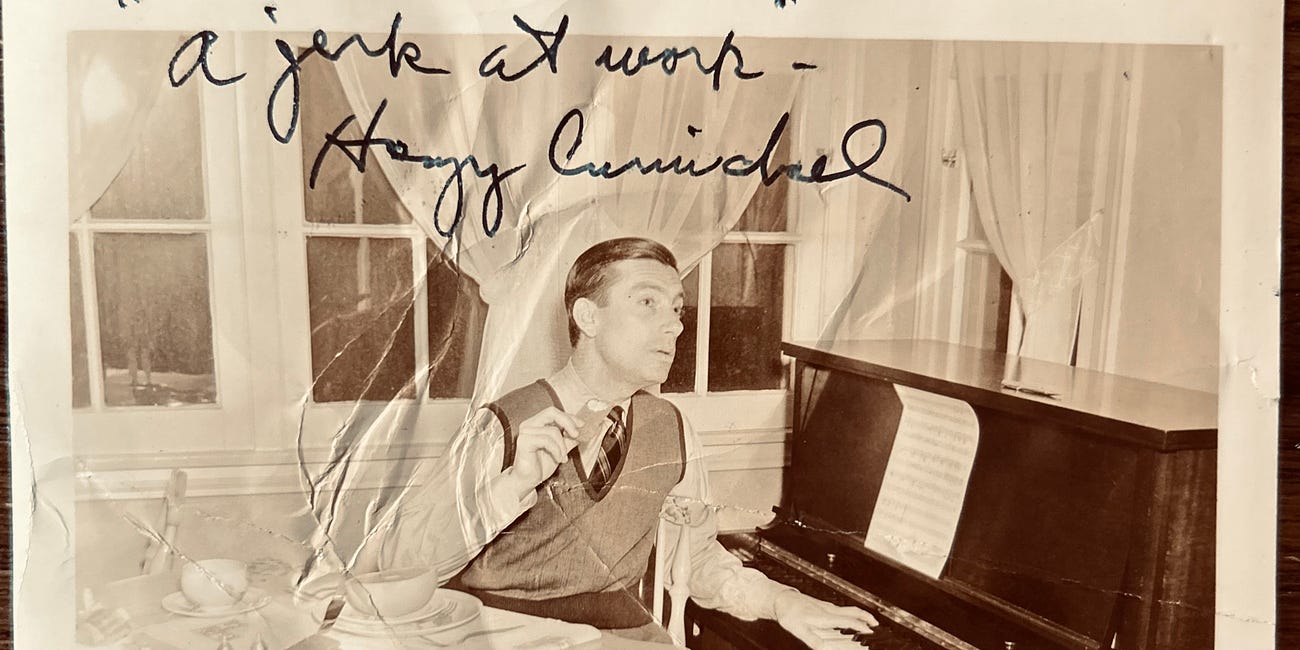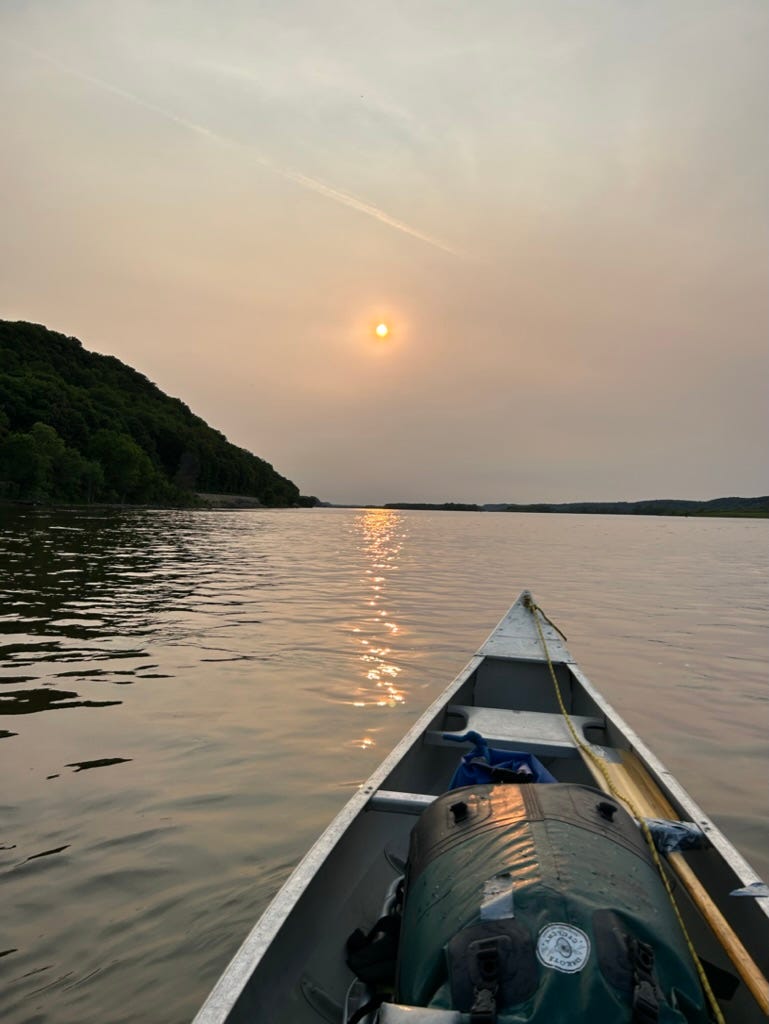I made it through the Quad Cities, and I am currently sending this while sitting on a dock at Sunset Marina just downriver from Rock Island, Illinois. The first leg of this journey on the river was an education.
I learned that from a canoe the beauty of the Mississippi River is astonishing. But the river can get very angry and exact a heavy price. You can’t cheat the river. You learn to take only what it gives you.
It is a river of dreams and floods - the beauty and the beast.
One of the beasts is man-made - the 29 locks and dams on the Upper Mississippi, with the last one near St. Louis; luckily, I can skip that one. They were meant to tame the river, but for the canoer, they are no friend. On this journey (counting my first journey in 2020, which began in St. Paul) I will need to pass through 25 locks. So far, I have passed 15. I have 10 to go.
The nastiest lock so far was in Dubuque, Iowa.
The leg of my journey from Finley’s landing to Dubuque was a killer. As the day went on the winds picked up considerably. As many of the dams on the upper Mississippi River do, the dam at Dubuque creates a huge lake - what I’ll call a lake. Although the lakes at dams further upriver were larger, like at Genoa (lock & dam 8) and Harper’s Ferry (lock & dam 9), the lake at Dubuque was a killer because, by the time I got there, the wind was steady with gusts up to 20 mph. I was fighting white caps head-on.
I planned to portage the lock, but the waves on the backside of the dam were gnarly. So, I went over to the Eagle Point Barge and Bar, which is right behind the dam, and asked if I could ride them. The owner Ashley told me that kayakers ride them and showed me the route they take saying, “It spits you out into the channel.”
I portaged the canoe and put in behind the dam.
Here’s a photo of the back of the Dubuque dam, and that’s the Eagle Point Barge and Bar on the left:
There was a man in a fishing boat where I put in, and I asked him to come and get me if things go wrong. He nodded at me and said, “I’ll keep an eye on you.”
I shot the river, got up into the channel, and then got smoked by the wind all the way to Catfish Charlie’s marina, where Ashley recommended I should go. It was only a couple of miles downriver, but I was gassed and had to line the canoe for a stretch in the Lake Peosta Channel. Here’s my rig tied up at Catfish Charlie’s Marina:
The day started at Finley’s landing and ended at the marina. I had only traveled 15 miles in about 11 hours. In all my years in a canoe, this was the single hardest day.
The forecast for the next day was rain and continued high winds, so with discretion being the better part of valor, I decided to take a weather day in Dubuque. I got a room across the street from the marina and went to bed. I hadn’t slept well the past two nights and after a long day battling the wind, I didn’t wake until almost 11 hours later.
Dubuque is a nice river town. The next morning I walked into town to take a look around. Downtown Dubuque is nice in that you can walk it and get a good feel for the city. I ran across the Fenelon Place Elevator up to the top of the bluff. It’s a 3-foot narrow-gauge funicular railway, known allegedly as the shortest and steepest in the world. Up top, you get a nice view of the river valley in both directions. Here’s an old picture and it hasn’t changed much - although now it’s $2 a ride:
After the ride, I got some coffee at La Venta, a new cafe in town run by a couple from Columbia. La Venta is the name of the small village they are from in southwestern Columbia. This is where the cafe gets its beans.
I walked around the Dubuque Historic Millworking District, which is very cool. The buildings are associated with two old local millworking firms, Carr, Ryder & Adams, and Farley Loetscher. In 1958, Carr, Ryder & Adams adopted the name Caradco which continued to manufacture from that location until 1968 when Scovill Manufacturing Company purchased them, and the operation moved to Rantoul, Illinois.
Incidentally, designed and built in 1971 by Capt. Dennis Trone, the Julia Belle Swain was the last steam-powered sternwheeler built by Dubuque Boat & Boiler Works. We’ll hear about the Julia Bell Swain a little further down the river…
The next morning, I waited out the rain and then was back on the river.
The Quad Cities is a bi-state, six-county metropolitan area that includes four cities: Davenport and Bettendorf, Iowa, and Moline and Rock Island, Illinois. When I think of Rock Island, I always recall Johnny Cash’s song Rock Island Line:
That’s the version I heard as a kid; however, Rock Island Line was originally sung as a spiritual by slaves on the plantations of the Mississippi River Valley. It was first transcribed as a folk song in 1929. The first recording was made by John Lomax, who was traveling among American South prisons to record spirituals dating from the antebellum South before they were lost forever.
Lomax met a remarkable singer named Huddie Ledbetter (who later performed under the name Lead Belly) at a prison in Louisiana in 1933 and helped secure Ledbetter’s release from prison. In 1937, Lead Belly made his first recording of the tune:
The Quad Cities’ Davenport is the home of Bix Beiderbecke.
Although Beiderbecke is more well-known, I was a fan of Frankie Trumbauer first. It was through him that I later learned about Bix. And it was through Lester Young that I first heard about Trumbauer.
On February 6, 1959, only weeks before Lester Young’s death, French jazz enthusiast Francois Positi interviewed him in Paris. When asked about his early influences, Young admits it was a tough choice between learning the style of Frankie Trumbauer or Jimmy Dorsey, two of his early favorite saxophonists:
In the interview, Young says, “You ever hear him play Singin’ the Blues? That’s where he tricked me - right there. That’s where I went.” Here’s that tune:
Trumbauer recruited Beiderbecke for Jean Goldkette's Victor Recording Orchestra and became its musical director. After leaving Goldkette, Trumbauer and Beiderbecke worked briefly in Adrian Rollini's short-lived New Yorkers band, then joined Paul Whiteman in 1927. The same year, Trumbauer signed a contract with OKeh and released this 78 rpm record of Singin' the Blues, which featured Beiderbecke on cornet and Eddie Lang on guitar.
Perhaps my favorite Trumbauer recording is For No Reason At All In C. This is a terrific opportunity to hear Trumbauer in a rare trio format with Beiderbecke on piano (plus cornet at the very end). Eddie Lang is on guitar:
More importantly, this is a rare chance to hear Beiderbecke on piano, although his more notable piano playing is on his solo recording In a Mist:
Leon Bismarck Beiderbecke was born in Davenport in 1903.
Here’s his childhood home, located on Grand Avenue about a half mile north of the river:
He started playing the piano at the age of three and transitioned to the cornet at 14. On summer evenings as a kid, sitting on their front porch, the Beiderbecke family could hear strains of New Orleans jazz floating up from riverboats pulling up at the docks below. In 1921, he decided to join them and started playing on the Mississippi riverboats. He later enrolled in the Lake Forest Military Academy near Chicago but was expelled a year later. He joined the Wolverines in 1923 and made his record debut in 1924.
Bix died on August 6, 1931, in Queens, New York. He was 28 years old. His body was taken to Davenport, where he was buried five days later. The Beiderbecke legend was given a fictional renaissance many years after his death by Dorothy Baker’s best-selling novel Young Man With A Horn, whose principal character was fashioned after the hard-drinking Bix Beiderbecke.
In 1950, a film by the same name was released by Warner Bros. It starred Kirk Douglas, Lauren Bacall, Doris Day, and Hoagy Carmichael:
This was Hoagy Carmichael’s 8th feature film. I wrote about him here:
Carmichael was always a great admirer of Bix and said that when he sat down to write songs he often heard the sound of Bix’s horn playing in the back of his mind.
In 1924 Carmichael composed a tune called Free Wheeling for Bix and the Wolverines for a recording session for the Gennett label. In 1927, Bix re-recorded the tune with Frank Trumbauer on the Okeh label and called it Riverboat Shuffle:
It’s been a tough first week on the river. The last time I was in a canoe was with my son Maclane when we went to the Boundry Waters Canoe Area in Northern Minnesota, almost a year before he passed away. On that trip, I sat in the back and Maclane sat up front with the map. As I paddle alone now, I see Maclane sitting up there in front of me. I can imagine him hunched over a map, studying the terrain, and pointing out the way to go. I feel his presence, helping me to navigate - pointing the way to go.
Next week, I hope to be reporting from Hannibal, Missouri. I’m not sure if I’ll make it there due to the fickle nature of the weather and, of course, the wait at the locks…
Please hit this link to buy me a cup of coffee if you’d like to show your guide some appreciation for this and past journeys. Know in advance that I thank you for your kindness and support.
If you like what you’ve been reading and hearing so far on our journey and would like to share this with someone you think might be interested in learning more about our great American art form, Jazz, just hit the “Share” button.
From Astaire to Sun Ra: A Jazz Journey is a reader-supported publication. To subscribe, please hit the “Subscribe now” button.
Feel free to contact me at any time to talk shop. I welcome and encourage that.
Until then, keep on walking….












I traveled this area last fall, by land! I am loving every minute of reading your post. What an adventure!!
Weather is such a cruel beast ... Hopefully you won't have much more!